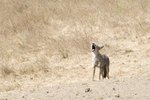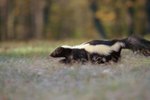
If you live in a rural area then you know that your small pets and farm animals may be vulnerable to coyote attacks. Coyotes are predators and will often attack smaller animals as well as livestock. There are several telltale signs of coyote activity that you can look for if you believe a coyote has attacked one of your animals.
Tracks
Look for coyote tracks in the area where your pet was attacked. Coyote tracks are similar to dog tracks but they are normally slightly slimmer and longer than those left by a domestic dog. Coyote tracks typically only leave marks from the first two claws rather than all four claws. The best place to look for coyote tracks are in areas that have a lot of sand, dirt or clay.
Scat
Coyotes may leave scat, otherwise known as feces or droppings, behind if they have been on your property. Coyote scat is normally approximately the size of a cigar and may be black or gray in color. Coyote scat typically contains evidence of the animal's diet so you may see see fur, bits of bones, wool, feathers and various animal parts as well as plant matter in Coyote droppings. Coyote scat is a sign that coyotes have been on your property and, if found near the area where a pet was attacked or disappeared from, can be a strong indicator of what happened.
Wounds
Coyotes typically bite larger animals directly behind the throat or jugular area. The victim may die of suffocation or shock. In smaller animals, the coyote will attack the head and neck area and may leave puncture wounds in the neck or throat. Coyotes do not commonly leave marks on the rest of the body. So wounds around the head or neck are a strong indicator of coyote activity when combined with other signs, such as howling and the presence of scat and tracks.
Prey Was Eaten
Coyotes do not attack prey animals for sport or pleasure. Coyotes attack to feed themselves and their young. If your pet was attacked and then eaten it is likely that a coyote is to blame. Coyotes start their meal by opening the abdominal cavity of the prey animal and eating the internal organs and muscle tissue. If the muscle tissue of your pet appears to have been ripped and the ribs or other bones appear to have been chewed on, then you are most likely looking at a coyote attack.
References
Photo Credits
-
Jupiterimages/Photos.com/Getty Images
Writer Bio
Jen Davis has been writing since 2004. She has served as a newspaper reporter and her freelance articles have appeared in magazines such as "Horses Incorporated," "The Paisley Pony" and "Alabama Living." Davis earned her Bachelor of Arts in communication with a concentration in journalism from Berry College in Rome, Ga.




